Themed collection Most popular 2021 main group, inorganic and organometallic chemistry articles, 2021

Azanone (HNO): generation, stabilization and detection
HNO (nitroxyl, azanone), joined the ‘biologically relevant reactive nitrogen species’ family in the 2000s.
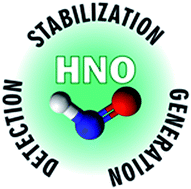
Chem. Sci., 2021,12, 10410-10425
https://doi.org/10.1039/D1SC02236A
Main group bimetallic partnerships for cooperative catalysis
Exporting cooperative effects in main group heterobimetallic reagents to catalytic regimes, this Perspective showcases key advances in their applications for hydroelementation, cyclisation, C–C bond formation and polymerization processes.
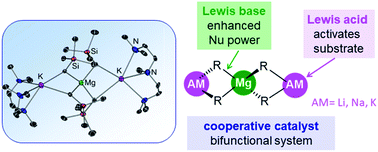
Chem. Sci., 2021,12, 1982-1992
https://doi.org/10.1039/D0SC05116K
Catalysis using transition metal complexes featuring main group metal and metalloid compounds as supporting ligands
Recent development in catalytic application of transition metal complexes having an M–E bond (E = main group metal or metalloid element), which is stabilized by a multidentate ligand, is summarized.
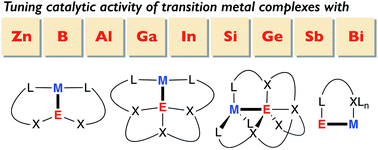
Chem. Sci., 2021,12, 1964-1981
https://doi.org/10.1039/D0SC04238B
Phosphorus-ylides: powerful substituents for the stabilization of reactive main group compounds
The application of ylide substituents as strong donor ligands for the stabilization of reactive main group compounds with unusual properties and reactivities is discussed.

Chem. Sci., 2021,12, 2016-2024
https://doi.org/10.1039/D0SC03278F
Direct synthesis and applications of solid silylzinc reagents
The first direct synthesis of PhMe2SiZnI and Me3SiZnI reagents from silyl iodides is described. They can be obtained as solids and stored at 4 °C for extended periods. The versatility of solid Me3SiZnI is demonstrated in a variety of reactions.

Chem. Sci., 2021,12, 15719-15726
https://doi.org/10.1039/D1SC06038D
When SF5 outplays CF3: effects of pentafluorosulfanyl decorated scorpionates on copper
Copper–ethylene and carbonyl complexes of the newly developed [Ph2B(3-(SF5)Pz)2]− enable the study of ligand steric and electronic effects caused by the –SF5 group (dubbed “super CF3”), and a comparison to the –CF3 bearing analogs.
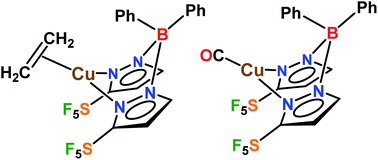
Chem. Sci., 2021,12, 14618-14623
https://doi.org/10.1039/D1SC04846E
Chromophore-radical excited state antiferromagnetic exchange controls the sign of photoinduced ground state spin polarization
A change in the sign of the ground state electron spin polarization (ESP) is reported in complexes where an organic radical (nitronylnitroxide, NN) is covalently attached to a donor–acceptor chromophore via two different meta-phenylene bridges.
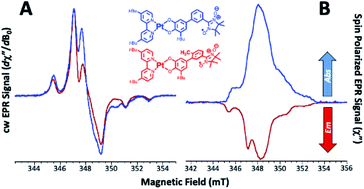
Chem. Sci., 2021,12, 13704-13710
https://doi.org/10.1039/D1SC02965G
Coinage metal aluminyl complexes: probing regiochemistry and mechanism in the insertion and reduction of carbon dioxide
The differential reactivity of copper, silver and gold aluminyl compounds towards CO2 and other heteroallenes are probed by experimental and quantum chemical methods.
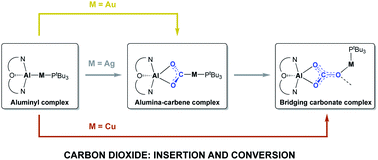
Chem. Sci., 2021,12, 13458-13468
https://doi.org/10.1039/D1SC04676D
Ultrafast and long-time excited state kinetics of an NIR-emissive vanadium(III) complex I: synthesis, spectroscopy and static quantum chemistry
Vanadium is an abundant and cheap metal but near-infrared luminescent vanadium complexes are extremely rare with largely unexplored photophysics and photochemistry. We delineate the photodynamics of VCl3(ddpd) to infer novel design strategies.
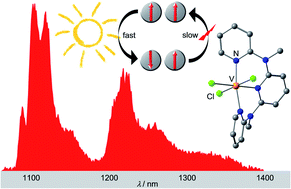
Chem. Sci., 2021,12, 10780-10790
https://doi.org/10.1039/D1SC02137K
Ultrafast and long-time excited state kinetics of an NIR-emissive vanadium(III) complex II. Elucidating triplet-to-singlet excited-state dynamics
The ultrafast triplet-to-singlet mechanism, responsible for the photoluminescence of the open-shell VIIICl3(ddpd) complex – based on Earth-abundant vanadium – is unraveled using non-adiabatic dynamics in full dimensionality.

Chem. Sci., 2021,12, 10791-10801
https://doi.org/10.1039/D1SC02149D
Coexistence of magnetic and electric orderings in a divalent Cr2+-based multiaxial molecular ferroelectric
An organic–inorganic hybrid perovskite Trimethylchloromethylammonium chromium(II) chloride (TMCM–CrCl3) can simultaneously show excellent ferroelectricity and antiferromagnetism, which is the first experimentally confirmed Cr2+-based multiferroic material.
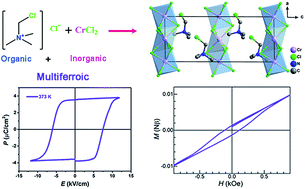
Chem. Sci., 2021,12, 9742-9747
https://doi.org/10.1039/D1SC01871J
Modulation of amyloid-β aggregation by metal complexes with a dual binding mode and their delivery across the blood–brain barrier using focused ultrasound
We report a series of non-toxic cobalt(III) complexes which inhibit Aβ peptide aggregation in vitro; these complexes can be safely delivered across the blood–brain barrier in mice using focused ultrasound.
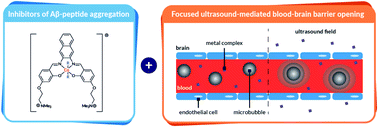
Chem. Sci., 2021,12, 9485-9493
https://doi.org/10.1039/D1SC02273C
Osmium(II) tethered half-sandwich complexes: pH-dependent aqueous speciation and transfer hydrogenation in cells
New Os(II) half-sandwich complexes bearing a pendant alcohol prompt reversible tether-ring formation upon aquation, protecting Os against deactivation. Excitingly, these complexes mediate hydrogenation of pyruvate to lactate inside cancer cells.
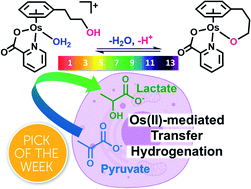
Chem. Sci., 2021,12, 9287-9297
https://doi.org/10.1039/D1SC01939B
Alloying a single and a double perovskite: a Cu+/2+ mixed-valence layered halide perovskite with strong optical absorption
A novel 2D halide perovskite with stoichiometric quantities of Cu+, Cu2+, and In3+ in the inorganic slabs shows emergent properties not seen in CuII or CuI–InIII perovskites, including enhanced visible-light absorption and electronic conductivity.

Chem. Sci., 2021,12, 8689-8697
https://doi.org/10.1039/D1SC01159F
Actinide tetra-N-heterocyclic carbene ‘sandwiches’
Highly-symmetrical, thorium and uranium octakis-carbene ‘sandwich’ complexes have been prepared by ‘sandwiching’ the An(IV) cations between two anionic macrocyclic tetra-NHC ligands, one with sixteen atoms and the other with eighteen atoms.
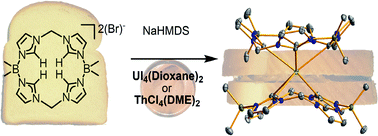
Chem. Sci., 2021,12, 7882-7887
https://doi.org/10.1039/D1SC01007G
Oxidative additions of alkynyl/vinyl iodides to gold and gold-catalyzed vinylation reactions triggered by the MeDalphos ligand
The hemilabile Ad2P(o-C6H4)NMe2 ligand promotes fast, quantitative and irreversible oxidative addition of alkynyl and vinyl iodides to gold.
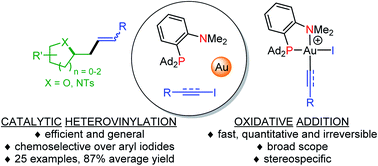
Chem. Sci., 2021,12, 7706-7712
https://doi.org/10.1039/D1SC01483H
How to not build a cage: endohedral functionalization of polyoxometalate-based metal–organic polyhedra
Installation of oversized functions within a metal–organic cage may “burst” or even transform the molecular cage itself.
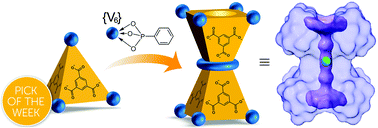
Chem. Sci., 2021,12, 7361-7368
https://doi.org/10.1039/D1SC01243F
Direct amidation of metallaaromatics: access to N-functionalized osmapentalynes via a 1,5-bromoamidated intermediate
The direct C–H amidation of metallapentalyne has been achieved under mild conditions in which key 1,5-bromoamidated intermediates was determined.

Chem. Sci., 2021,12, 6315-6322
https://doi.org/10.1039/D1SC01571K
Reversible metathesis of ammonia in an acyclic germylene–Ni0 complex
Chelating single-centre ambiphile ligands based upon low-coordinate, acyclic germylenes have been developed, remaining highly Lewis acidic even when bound to Ni0, remarkably allowing for the reversible metathesis of the N–H bonds in ammonia at GeII.
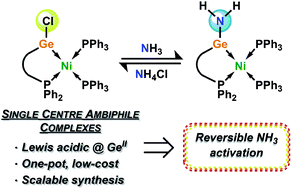
Chem. Sci., 2021,12, 5582-5590
https://doi.org/10.1039/D1SC00450F
Trioxatriangulenium (TOTA+) as a robust carbon-based Lewis acid in frustrated Lewis pair chemistry
Frustration at carbon! Herein, we present a frustrated Lewis pair system derived from a water stable carbon-based Lewis acid, trioxatriangulene (TOTA+), and a variety of Lewis bases, which successfully promotes bond cleavage and molecule fixation.
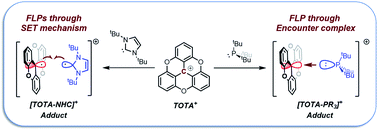
Chem. Sci., 2021,12, 4841-4849
https://doi.org/10.1039/D0SC05893A
Pressure-induced phosphorescence enhancement and piezochromism of a carbazole-based cyclic trinuclear Cu(I) complex
One molecule, two response mechanisms: a pair of newly-designed cyclic trinuclear Cu(I) complex crystalline polymorphs are engineered, which show excellent luminescent piezochromism and pressure-induced phosphorescence enhancement, respectively.
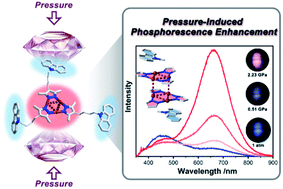
Chem. Sci., 2021,12, 4425-4431
https://doi.org/10.1039/D0SC07058K
Photoredox catalysis on unactivated substrates with strongly reducing iridium photosensitizers
Strong bis-cyclometalated iridium photoreductants, in combination with a single sacrificial reductant, enable visible-light-promoted reductive activation of a variety of challenging substrates under simple and general reaction conditions.
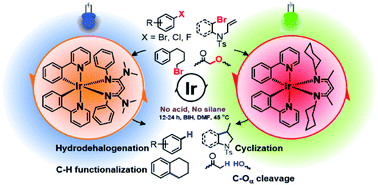
Chem. Sci., 2021,12, 4069-4078
https://doi.org/10.1039/D0SC06306A
On the location of Lewis acidic aluminum in zeolite mordenite and the role of framework-associated aluminum in mediating the switch between Brønsted and Lewis acidity
Framework-associated aluminum is demonstrated to facilitate a reversible switch between Lewis and Brønsted acidity in zeolites with the Lewis acid sites preferentially populating the side-pockets in the case of mordenite.
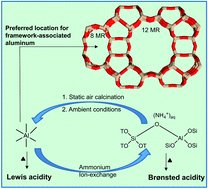
Chem. Sci., 2021,12, 4094-4103
https://doi.org/10.1039/D0SC06130A
Towards the stable chelation of radium for biomedical applications with an 18-membered macrocyclic ligand
The therapeutic alpha-emitter 223Ra can be stably complexed in vivo, creating opportunities for the development of targeted radiopharmaceutical agents with this radionuclide.
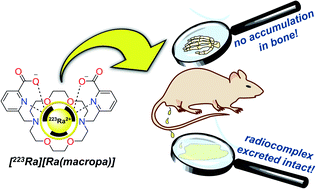
Chem. Sci., 2021,12, 3733-3742
https://doi.org/10.1039/D0SC06867E
Revealing the bonding of solvated Ru complexes with valence-to-core resonant inelastic X-ray scattering
Combined experimental and theoretical Ru 2p4d resonant inelastic X-ray scattering study probes the chemical bonding and the valence excited states of solvated Ru complexes.
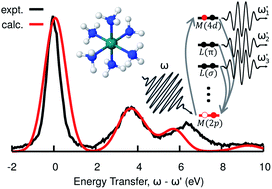
Chem. Sci., 2021,12, 3713-3725
https://doi.org/10.1039/D0SC06227H
Soluble, crystalline, and thermally stable alkali CO2− and carbonite (CO22−) clusters supported by cyclic(alkyl)(amino) carbenes
The direct chemical reduction of CAACCO2 adducts by alkali metals to yield multinuclear clusters is reported. The mono- and dianions of CO2 have been studied for decades and are fundamentally important oxycarbanions and critical species in CO2 fixation chemistry.
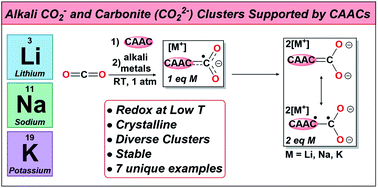
Chem. Sci., 2021,12, 3544-3550
https://doi.org/10.1039/D0SC06851A
Magnesium–halobenzene bonding: mapping the halogen sigma-hole with a Lewis-acidic complex
Complexes of a highly Lewis acidic Mg cation and the full series of Ph–X (X = F, Cl, Br, I) have been structurally characterized. The Mg⋯X–Ph angle decreases with halogen size on account of the growing halogen σ-hole.

Chem. Sci., 2021,12, 2410-2418
https://doi.org/10.1039/D0SC06321E
A protecting group strategy to access stable lacunary polyoxomolybdates for introducing multinuclear metal clusters
A “protecting group strategy” for unstable lacunary polyoxomolybdates enabled successful synthesis of two types of tetranuclear manganese clusters.
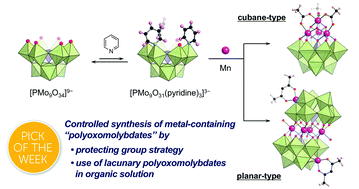
Chem. Sci., 2021,12, 1240-1244
https://doi.org/10.1039/D0SC06133F
Nucleophilic reactivity of the gold atom in a diarylborylgold(I) complex toward polar multiple bonds
A di(o-tolyl)borylgold complex added to C![[double bond, length as m-dash]](https://www.rsc.org/images/entities/char_e001.gif) O/N double bond to form Au–C and B–O/N bonds. DFT calculations revealed a two-step mechanism consisting of the coordination of O/N atom to B atom followed by nucleophilic migration of Au atom.
O/N double bond to form Au–C and B–O/N bonds. DFT calculations revealed a two-step mechanism consisting of the coordination of O/N atom to B atom followed by nucleophilic migration of Au atom.
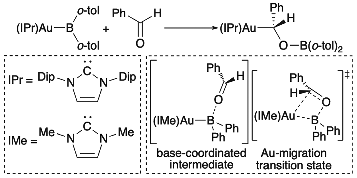
Chem. Sci., 2021,12, 917-928
https://doi.org/10.1039/D0SC05478J
Thermo- and light-triggered reversible interconversion of dysprosium–anthracene complexes and their responsive optical, magnetic and dielectric properties
[DyIII(SCN)3(depma)2(4-hpy)2] (1) shows reversible thermo-induced phase transition associated with thermochromism and dielectric anomaly and photo-induced dimerization with synergistic switching of luminescence, magnetic and dielectric properties.
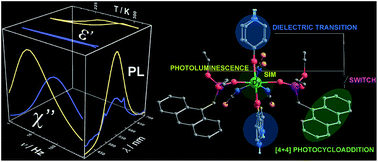
Chem. Sci., 2021,12, 929-937
https://doi.org/10.1039/D0SC04851H
Holmium(III) molecular nanomagnets for optical thermometry exploring the luminescence re-absorption effect
HoIII complexes bearing organic luminophores and inorganic metalloligands are an effective tool for achieving the unique conjunction of single-molecule magnetism and thermometric luminescence re-absorption phenomenon.

Chem. Sci., 2021,12, 730-741
https://doi.org/10.1039/D0SC04871B
“Bottled” spiro-doubly aromatic trinuclear [Pd2Ru]+ complexes
Synthesis of a triangular [Pd2Ru]+ complex with delocalized metal–metal bonding between non-adjacent elements of the periodic table, double aromaticity and overlap of d-AOs with different angular momentum.
![Graphical abstract: “Bottled” spiro-doubly aromatic trinuclear [Pd2Ru]+ complexes](/en/Image/Get?imageInfo.ImageType=GA&imageInfo.ImageIdentifier.ManuscriptID=D0SC04469E&imageInfo.ImageIdentifier.Year=2021)
Chem. Sci., 2021,12, 477-486
https://doi.org/10.1039/D0SC04469E
About this collection
About this collection: This specially curated collection pulls together some of the most popular articles from 2021 in the field of inorganic, main group and organometallic chemistry. The collection presents some outstanding contributions to the field, ranging from Holmium(III) molecular nanomagnets for optical thermometry to Osmium(II) tethered half-sandwich complexes for pH-dependent aqueous speciation and transfer hydrogenation in cells. As with all Chemical Science articles – they are all completely free to access and read. We hope you enjoy browsing through this collection.
If a particular article has inspired you, do feel free to share on social media using the buttons on each article landing page and use our hashtag: #ChemSciMostPopular